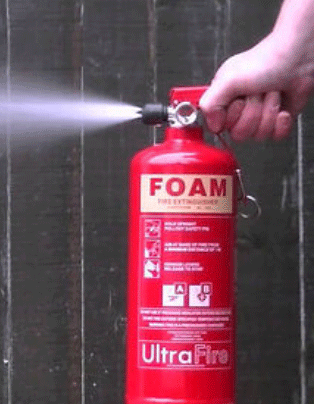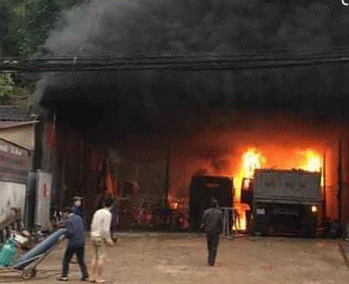Fire extinguisher for car maintenance workshop
Auto repair shops have many potential fire hazards, from flammable liquids to high-tech equipment, plus potentially flammable mixtures of dust, foam and lubricants. So you should be prepared. Give your workshop at least two different types of fire extinguishers
So we ask the question: what class do fires in auto maintenance workshops belong to? That is a class A fire, so what type of Fire extinguisher for car maintenance workshop should be used?
- Class A fires involve fabrics and plastics, which pretty much describes the interiors of most cars today. Your office area is also highly flammable, including papers, files, chairs, and desks.
- Foam fire extinguishers are suitable for use on Class A fires, and are a highly cost-effective item of fire-fighting equipment for automobile warranty and maintenance workshops.

Bình chữa cháy cho xưởng bảo dưỡng ô tô (bình chữa cháy bọt foam)
What is Foam?
- Foam is foam used for firefighting. Its role is to cool the flame and cover the fuel, preventing its contact with oxygen, leading to inhibition of combustion. Firefighting foam was invented by Russian chemist Alexander Loran in 1902.
- The surfactants used must create foam at a concentration of less than 1%. Other components of fire retardant foam are organic solvents (e.g. rimethyl- trimylene glycol and hexylene glycol) foam stabilizers (lauryl alcohol) and corrosion inhibitors (en.wikipedia).
- A fire can start and exist when and only when there are 4 main elements including: heat, fuel, oxidizing agent (usually oxygen) and chemical reaction between the 3 elements. This. Fire incidents can be prevented or completely extinguished by eliminating 1 of 4 factors.
- Foam in firefighting Foam foam tank is made up of condensed foam, water and air. When mixed correctly, these ingredients form a foam layer that covers the gasoline surface, separating the flammable liquid from the air and fire; cooling; degassing and evaporation for fire suppression. This makes Foam foam fire suppression systems an effective choice for protecting, preventing fires and fighting fires in areas where flammable liquids are present.
Foam Foam Bottle Structure Foam foam tank is made up of tank body, valve, nozzle, trigger, propellant gas, pipes and firefighting Foam foam, specifically as follows: Outside The tank body is made from steel that can withstand high pressure, the tank is cylindrical in shape and is often painted red. On the body of the bottle, there is a label printed with information about the bottle's characteristics, images of use, how to preserve it, etc. On the mouth of the fire extinguisher there are valves, lock valves, pressure gauges, pipes, nozzles and triggers. Inside Inside the firefighting Foam foam tank there is Foam foam, propellant gas and a pipe connected directly to the valve assembly on the mouth of the tank. The firefighting foam inside the tank can be AFFF Foam, ARC Foam,... AFFF Fire Fighting Foam has a fire extinguishing agent that forms a mist over the flat surface of the hydrocarbon fuel. Foam ARC (alcohol-resistant concentrate) is a foam that, when sprayed, creates a mucus film on the surface of insoluble fuel. Choosing to Use a Foam Fire Extinguisher Foam fire extinguishers are used to extinguish fires: Fires involving flammable solids, such as paper, wood and textiles (‘class A’ fires) Fires involving certain flammable liquids, such as gasoline, diesel and paint (‘class B’ fires) Fires involving electrical equipment IF the extinguisher has passed the 35kv conductivity test- an additional safety measure to protect users from accidentally using a foam extinguisher on an electrical fire. Please note: Not all foam fire extinguishers are designed for use on electrical fires. Only extinguish electrical fires with foam when the house is authorized by the manufacturer. Do not use Foam fire extinguishers for: Cooking fires involving oils and greases, such as chip fires (‘class E’ fires) Fires involving flammable gases, such as methane and butane (‘class C’ fires) Advantages and Disadvantages of Foam Fire Extinguishers Advantages: non-toxic, not harmful to most materials, largely safe if accidentally used on electrical fires (although this is not recommended), designed to prevent fires Fire flares up again, lighter weight than equivalent water fire extinguishers. Disadvantage: damages electrical equipment. Dangerous if used over a cooking fire or flammable gas fire. Application of Fire Fighting Foam Foam Foam fire extinguishers are ideal fire extinguishers for facilities with multiple fire risks, such as: Office Depot Factory Garage Hotel In fact, most premises benefit from the use of foam extinguishers and these are often recommended, especially when combined with CO2 extinguishers for use on electrical fires. How to Use Foam Fire Extinguisher Foam fire extinguishers need to be used differently, depending on the type of fire. In all cases, you first need to remove the safety pin and stand at a safe distance from the fire. Flammable liquid For flammable liquid fires, do not use Foam spray directly on the fire because it may cause the liquid to spread to nearby surfaces. In this case, spray the fire extinguishing foam gently, over the tip of the fire and around the liquid. This way, the foam will fall, settle and prevent the flammable liquid from spreading around. Flammable solid With solid fires, you can spray firefighting foam onto the fire. Electrical fire (not recommended) Handle similarly to flammable solid fires. Make sure you are standing at least 1 meter away from the fire to minimize the risk of electric shock

Bình chữa cháy cho xưởng bảo dưỡng ô tô
2. Fire extinguisher CO2 extinguish electrical fires
- For electrical equipment, such as testers, computers and even printers, you should equip your auto repair shop with CO2 fire extinguishers.
- This fire extinguisher works by extinguishing the fire in a cloud of super cool CO2 gas so it does not leave residue on electrical equipment or conduct electricity during use.
- Also consider the size of your workshop and the time it may take a mechanic or employee to reach any given fire extinguisher.
- Also consider the capacity of the fire extinguishers you may require; All types of fire extinguishers come in a variety of capacities, from the familiar freestanding fire extinguishers to wheeled fire extinguishers with capacities up to 100kg/litre.
>>> Effective use and use of unburned CO2 cylinders >>>
The conclusion of the article is for you to use Fire extinguisher for car maintenance workshop. There are 02 types that we need to pay attention to to help you have effective fire extinguishing plans whenever a fire or explosion occurs in a car garage. repair workshops.
.

Have 0 comment, evaluate about Fire extinguisher for car maintenance workshop
TVAdministratorsAdministrators
Welcome, honored guests. Please leave a comment, we will respond soon